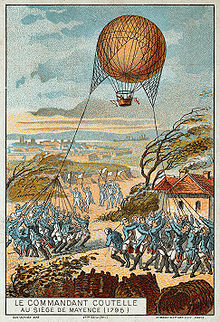Captive balloon
A tethered balloon is a balloon filled with a lifting gas , which, similar to a kite or a tethered aircraft and in contrast to a free balloon, always remains connected to the ground by a line. The buoyancy principles gas balloon or hot air balloon are possible .
Tethered balloons above a certain size can be elongated in a streamlined manner and shaped with a tail unit at the rear. Integrated flow channels or built-on kite surfaces can be used to maintain height in strong winds.
A free balloon, which has the increasing length of an anchor rope dragged on the ground in order to slow down horizontal travel before landing, gradually takes on the characteristics of a tethered balloon via the pulling force in the rope. Balloons heavier than air, which are attached to a crane or bridge, for example for lighting, decoration or as a projection surface, are rarely referred to as tethered balloons, although they have the same function apart from buoyancy. The same goes for buoys and lifting balloons .
History and use

For the Battle of Fleurus (1794) , the doctor and captain Jean Marie Joseph Coutelle rose on the French side with the military balloon Entreprenant for the first long-range aerial reconnaissance in history. Nicolas-Jean de Dieu Soult said in his memoirs that these observations had no influence on the battle. The Intrépide military balloon , which was captured on September 3, 1796 in the Battle of Würzburg and is exhibited in the Vienna Army History Museum as the oldest surviving military aircraft , also dates from this period .
Tethered balloons were mainly used in the First World War , but partly also in the Second World War, for tactical battlefield reconnaissance (see under field airship and balloon ship ) or as blocking balloons against low-flying aircraft. Another application that is still carried out today is the dragging up of an antenna wire for a transportable long-wave or long- wave transmitter . An example of this was the test transmitter GQV in Great Britain. At the beginning of the 20th century, large warships were often equipped with tethered balloons. They served on the one hand for remote observation of the lake area and on the other hand to improve radio communication.
Tethered balloons were also used to position the atomic bomb at altitudes between 100 and 2000 meters during atomic bomb tests . Recently, tethered balloons have been used primarily in advertising as an eye-catcher for large advertisements.
Advertising balloons and light balloons
Small, unmanned tethered balloons and tethered, streamlined balloons with stabilizing fins ( blimps ) were already used in the early years of their development as carriers of political and advertising-relevant messages. Since the early 1980s, smaller tethered balloons have also been produced exclusively for advertising purposes. These advertising balloons are mainly used for light, welded PVC films, PU films or nylon fabrics / PU laminates.
Advertising labels are either printed directly onto the balloon envelope or attached using removable banners . Usually helium is used to fill these advertising balloons .
Small tethered balloons are also often used as luminous balloons for film productions and area illumination. The light balloons are usually operated below 30 m altitude and have interior lighting of 500 to 8000 W power. Special metal halide lamps (so-called HMI burners) are used for film applications .
Large tethered balloons with a carrying basket for people as a tourist attraction are in use in Berlin ( Checkpoint Charlie ), Hamburg , Paris , Chantilly and at Disneyland Resort Paris , among others . They offer passengers a wide view of the surrounding landscape, but have led to controversy in the context of a HiFlyer accident in the Verkehrshaus Luzern .
The tethered balloons used as advertising balloons and light balloons have a diameter of 1 to 12 m and are usually operated unmanned. They can also be used for payloads such as cameras and measuring probes.
Solar balloons

Solar balloons should only be released tied up so as not to endanger air traffic. The mostly tubular, almost opaque black, but extra-thin polyethylene film is heated on one side by the sun's radiation, especially the infrared component, significantly above the temperature of the surrounding air, which means that the enclosed air is warmed up more strongly than the surrounding air, which is constantly passing by. If the radiation is intense enough and the ambient air is sufficiently dense (cold and low altitude are helpful here), the difference in density between the outside air and the inside air can be sufficient to lift the balloon. Cold and light (near) ground favor a high relative temperature rise of the balloon; the sun which is not too high can be beneficial, especially if the elongated balloon is oriented vertically.
Balloons, which utilize solar radiation more efficiently, have the absorption surface behind a transparent skin and an insulating gas layer.
Air law

In Germany, tethered balloons along with its counterpart, the free balloons air legally own aircraft class considered. In Switzerland , a permit is required to operate a captive balloon if it is manned or weighs over 30 kg.
See also
Individual evidence
- ^ Manfried Rauchsteiner, Manfred Litscher: The Heeresgeschichtliche Museum in Vienna. Verlag Styria, Graz, Vienna 2000, 37.
- ↑ Clive S. Carver: Balloon supported 4,200 foot aerial. www.lwca.org, December 19, 2007, accessed August 18, 2011 .
Remarks
- ↑ Since the sources are not clear, the first aerial reconnaissance could have taken place at Maubeuge.


